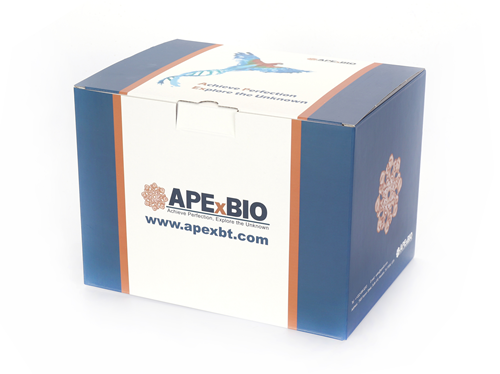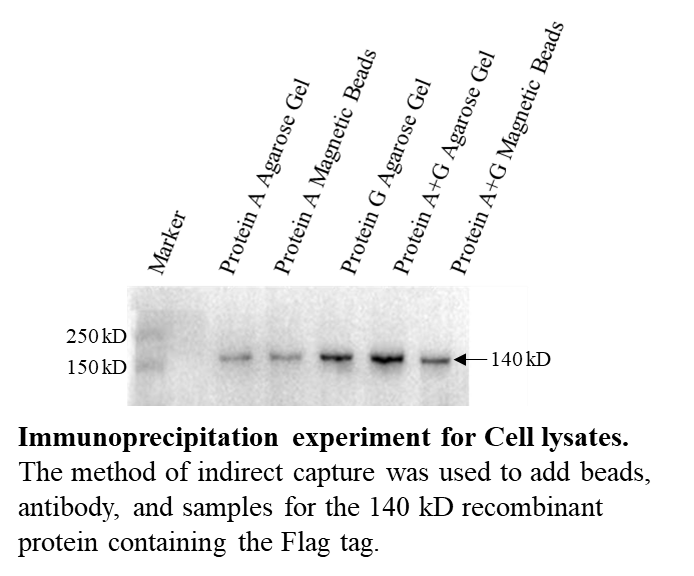Immunoprecipitation Kit (Protein G Agarose Gel)
Immunoprecipitation (IP) or co-immunoprecipitation (Co-IP) is a common technique used to study proteins or protein-protein interactions (PPIs) by using specific antibodies and antibody-binding mediators (e.g., Protein A/ G agarose gels, etc.), or directly use a medium conjugated to a specific antibody (such as an agarose gel or magnetic beads) to separate the protein of interest from complex samples, which can then be used for Western blot detection or mass spectrometry analysis.
Protein G is an immunoglobulin-binding protein expressed by Streptococcal bacteria type C or G, which specifically binds to mammalian immunoglobulin (Ig). Fc zone binding. Protein G can bind to human IgG1, IgG2, IgG3, IgG4, mouse IgG1, IgG2a, IgG2b, IgG3, rat IgG1, IgG2a, IgG2b, IgG2c, rabbit, goat polyclonal antibodies, etc., and each Protein G molecule can bind 3 IgG molecules. The binding capacity of common immunoglobulin subclasses and the total binding capacity of different species are shown in the table below (Table 1).
This kit contains Protein A agarose gel and other necessary reagents for immunoprecipitation, and with the specific antibodies provided by the user, it makes immunoprecipitation (IP, also known as pull-down) or co-immunoprecipitation (Co-IP) experiments simpler, more convenient and efficient, and the immunoprecipitation products can be used for the detection of the target protein or its protein complexes and other experiments. (See Table 2 for specific product parameters)
|
Species |
Subclass |
Protein A binding |
Protein G binding |
|
Human |
lgA |
++ |
- |
|
lgD |
++ |
- |
|
|
IgE |
++ |
- |
|
|
lgG1 |
++++ |
++++ |
|
|
lgG2 |
++++ |
++++ |
|
|
IgG3 |
- |
++++ |
|
|
lgG4 |
++++ |
++++ |
|
|
lgM |
++ |
- |
|
|
Mouse |
IgG1 |
+ |
++++ |
|
lgG2a |
++++ |
++++ |
|
|
lgG2b |
+++ |
+++ |
|
|
lgG3 |
++ |
+++ |
|
|
lgM |
+/- |
- |
|
|
Rat |
lgG1 |
- |
+ |
|
lgG2a |
- |
++++ |
|
|
lgG2b |
- |
++ |
|
|
lgG3 |
+ |
++ |
|
|
Avian egg yolk |
IgY |
- |
- |
|
Cow |
|
++ |
++++ |
|
Dog |
|
++ |
+ |
|
Goat |
|
- |
++ |
|
Guinea Pig |
lgG1 |
++++ |
++ |
|
lgG2 |
++++ |
++ |
|
|
Hamster |
|
+ |
++ |
|
Horse |
|
++ |
++++ |
|
Koala |
|
- |
+ |
|
Llama |
|
- |
+ |
|
Monkey (rhesus) |
|
++++ |
++++ |
|
Pig |
|
+++ |
+++ |
|
Rabbit |
|
++++ |
+++ |
|
Sheep |
|
+/- |
++ |
Table 1 Affinity data for Protein G for different sources and subtypes of IgG. ++++ = Strong Binding; ++~+++ = Medium Binding; + = Weak Binding; +/- = Weak or No Binding; - = No Binding.
|
Characteristics |
Description |
|
Product content |
Store in 20% ethanol with a glue-to-suspension ratio of approximately 75% |
|
Bead structure |
4% cross-linked agarose |
|
Average beads size |
90 μm |
|
Coupled protein |
Recombinant Protein G (E. coli) |
|
M. W. of protein |
22 kDa Protein G |
|
Ligand concentration |
~2 mg Protein G per ml settled gel |
|
Binding capacity |
≥20 mg human IgG per ml settled gel |
|
Elution method |
Elution with acid, competing peptide or SDS-PAGE loading buffer |
|
Operating temperature |
4-30℃ |
|
pH stability* |
3-9 |
|
Solvent resistant |
Common aqueous solution, 30% isopropanol**, 75% ethanol**, 6 M guanidine hydrochloride, 8 M urea |
|
Application |
Suitable for IP, Co-IP, Protein purification |
|
Storage |
4°C |
|
*After 7 days of storage at 40°C, pH 3-9, the physicochemical properties, and functions of agarose showed no significant changes. ** v/v, volume ratio |
|
Table 2 The main related indicators of Protein G Agarose Gel.
| Components | K4622-20 T |
| Cell Lysis Buffer | 50 mL |
| Protease Inhibitor Cocktail (EDTA-Free,100X in DMSO) | 0.5 mL |
| 10X TBS | 10 mL |
| Neutralization Buffer | 200 μL |
| Acid Elution Buffer | 2 mL |
| Protein G Agarose Gel | 400 μL |
| 5X Protein Loading Buffer (Reducing) | 600 μL |
Store Protease Inhibitor Cocktail (EDTA-Free,100X in DMSO) and 5X Protein Loading Buffer (Reducing) at -20°C and the rest of components at 4°C for 12 months. | |









